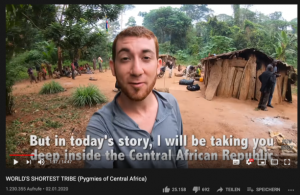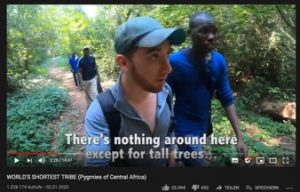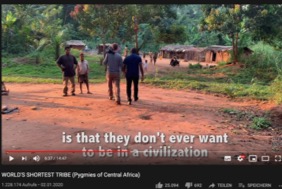Racial attributions and stereotyping can be found widely distributed all over the web. Often, this happens “unintentionally” and can be found in travel vlogs. This blogtext is aiming to do a Critical Discourse analysis on a Youtube video, produced by Drew Binsky. It serves as an assignment, for a course named Language & Communication, having “Cultural Violence” as its semester’s theme. It is an episode out of three, of the series “Analysing travel vlogs” (to see the other episodes please click on the links provided).
Sudi’s episode on 12 travel tips for Africa
Ryohei’s episode on Mozambique
Cultural violence is defined as “any aspect of a culture that can be used to legitimize violence in its direct or structural form” (Galtung, 1990, p. 291). This symbolic violence does not immediately physically harm anyone and lead to death like direct violence could do (Galtung, 1990). Yet, racism is indeed a violent act and also an example of cultural violence in language use. Cultural violence has many aspects, but in this blogtext, the aspect of language will be researched and examined how violent perspectives are legitimized.
This year, Drew Binsky is believed to have reached a net worth of at least 1 million USD, just by traveling and “portraying” people on the internet in his very own way. He can afford to live from traveling through receiving sponsorships, cooperating with firms and putting videos on platforms, as he describes for himself on his personal website (Binsky). This travel vlogger has already reached 2.11 million followers on Youtube and several hundred thousands on other social media platforms.

The here presented example is a video which he named “WORLD’S SHORTEST TRIBE (Pygmies of Central Africa)” (Binsky, 2020). On his personal website, Binsky claims to have a major in “entrepreneurship”, yet he does not in history or area studies, for example. In the latters, the word “pygmy” is subject of discussion and considered a quite problematic term. People living in the Central African forests were historically presented as the alien “Other”, whereas explorers from the outside were represented as the “Self” (Kidd, 2009). In these historical representations, people were reduced to being primitive and transformed from an imagined to an experienced “Other” (Kidd, 2009). At the same time, “they became a curiosity for all who came in contact with them” (Kidd, 2009, p. 403).
Again, this travel video is by no means an accurate presentation of a certain community, but rather a brief glimpse that a traveler got. Binsky depicted the people as living far in the forest, in “nowhere”. There, he believes, they live a “stressful and simple” life. He compared his impressions of the community to the citylife he has been used to, where his definition of stress derived from. He even asked one local, who said he was the chief, about potential stress or worries, whom answered (this was translated by another person), that people could feel stress everywhere and gave examples. Binsky did show this scene, however, he also stated in his own words that they would not experience stress. That any individual on the globe might experience varying forms of “stress” was hereby ignored and local realities were brushed off. Binsky repeatedly pointed at the beauty of this place and was eager to create romantic impressions among the audience.

In the video’s title, he reduced them to their physical appearance, rolled them into one racial term and presented them to a broad audience as the curious “Other”, whom he got to visit. He also referred to them being far away from the “standard human being” and points out their “genetic uniqueness” regarding the height. He also showed an image, where the people he visited, lined up and he presented himself next to them, to visually point out the curiosity. This very old narration by Western travelers and explorers, who penetrate deeply into Africa’s heart and find “curious people”, can still be found on Youtube today.
The reason, why he would spend “full 24 hours” was, according to him, to “really immerse” himself “in their way of life”. What he tried his audience to believe, is, that, he was interested in the people and made an effort to “understand” them. Yet, spending 24 hours are not sufficient to truly understand a whole community and then be able to “create” a collective identity. By creating the image, spending such a short amount of time with the community members and portraying them in a 15 minutes video would be enough for an accurate depiction, is oversimplified and reduced. The condensed portrayal strengthens stereotypes of the easy to explain and curious “Other”.
During the walk he undertook to get to the people, he claimed to be “in the middle of nowhere”, that he couldn’t believe that people actually lived there and that “there’s nothing around here except for tall trees”. He continued to describe what they don’t have and stated that they don’t have material possessions. A whole list was made of things they were missing and experiences they were lacking, in contrast to him. Questions such as “do you have any interests”, “do you experience any stress”, “do you understand that I am from a different country”, “have you ever seen a white person like me”, “have you ever been to a city” show his preconceived image. It also strengthens the underlying concept of imagined boundaries between the city-“Self” and the “Other” in the forest which required to be proven.

Furthermore, that every day would be the same for them and that “they don’t ever want to be in a civilization” create an image of people, who are considered as a monotonous counterpart to civilization. Portraying them as deviation from civilization might remind of the above alluded historical primitive representation. Yet “they sing and they dance and they have a great life”. By pointing out what they are all lacking, is first of all, not proven by him, and second, the imagination of they have nothing, yet they are happy is another means of reproducing stereotypes of the curious “Other”, whom are claimed to be satisfied with so little.
In the end, one local is believed to have said, that he was happy about his interest in him and his community. It is indeed nice, when people seem to be interested in oneself. However, it turned out that the video contains several belittling and disparaging sections as well as racial descriptions. The travel vlogger had his very own way of living in mind, which he set as a narrowly defined standard and pointed out how far the “Other” would “deviate” from that. After a brief visit of 24 hours, he created an imagined collective identity which could fit in a 15 minute video. The somewhat negative attributions might have been created unintentionally. Repeated statements, that the place would be beautiful and the people friendly, might have been well intended. However, the portrayal is quite condensed, strengthens boundaries between Self and Other, and problematic comments may be overlooked in a romanticized depiction. He gave the journey a framing, where his good intentions repeatedly are expressed. The provided positive framing can then work as a legitimization for pejorative comments and stereotyping and in the end, considered as being culturally violent.
! This video could have been analysed to a much larger extent, but needed to be precise in this blog-format.
This episode will be followed by other episodes of “Analysing travel vlogs”, where similar findings where made. After analysing the three videos, we found: stereotyping, pejorative and belittling statements, oversimplification, short stays and generalisations, little knowledge and unawareness of destinations’ realities. We also believe, that travel vloggers with such an amount of followers and hence influence on people, should take responsibility and avoid portrayals like these.
Literature:
Binsky, D. https://drewbinsky.com/
Binsky, D. (2020). WORLD’S SHORTEST TRIBE (Pygmies of Central Africa) https://www.youtube.com/watch?v=Q_ndHZ5Mb2U [6.12.2020]
Galtung, J. (1990). Cultural Violence. Journal of Peace Research, 27(39), 291–305.
Kidd, C. (2009). Inventing the “Pygmy”: Representing the “Other”, Presenting the “Self”. History and Anthropology, 20(4), 395–418.

